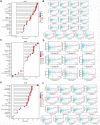Comprehensive Analysis of Prognostic Value and Immune Infiltration of Ficolin Family Members in Hepatocellular Carcinoma
- PMID: 35928441
- PMCID: PMC9343789
- DOI: 10.3389/fgene.2022.913398
Comprehensive Analysis of Prognostic Value and Immune Infiltration of Ficolin Family Members in Hepatocellular Carcinoma
Abstract
Objective: Ficolin (FCN) family proteins are part of the innate immune system, play a role as recognition molecules in the complement system, and are associated with tumor development. The mechanism of its role in immunotherapy of hepatocellular carcinoma (HCC) is unclear. Methods: In this study, we used the TCGA database, HPA database, Gene Expression Profile Interaction Analysis (GEPIA), Kaplan-Meier plotter, TCGAportal, cBioPortal, GeneMANIA, TIMER, and TISIDB to analyze Ficolin family proteins (FCN1, FCN2 and FCN3, FCNs) in patients with hepatocellular carcinoma for differential expression, prognostic value, genetic alterations, functional enrichment, and immune factor correlation analysis. Results: The expression levels of FCN1/2/3 were significantly reduced in patients with HCC. Among them, FCN3 showed significant correlation with Overall Survival (OS), Progressive Free Survival (PFS) and Relapse Free Survival (RFS) in HCC. FCN1 and FCN3 may be potential prognostic markers for survival in patients with HCC. In addition, the functions of differentially expressed FCNs were mainly related to complement activation, immune response, apoptotic cell clearance and phagocytosis. FCNs were found to be significantly correlated with multiple immune cells and immune factors. Expression of FCN1 and FCN3 differed significantly in the immune and stromal cell component scores of HCC. analysis of the tumor mutation burden (TMB) and microsatellite instability (MSI) of FCNs with pan-cancer showed that FCN3 was significantly correlated with both. Conclusions: Our study provides new insights into the link between the FCN family and immunotherapy for HCC, and FCN3 may serve as a prognostic biomarker for HCC.
Keywords: bioinformatics analysis; ficolin family; hepatocellular carcinoma; immunotherapy; prognosis.
Copyright © 2022 Sun, Yu, Dong, Wu, Huang, Chen, Wu and Yin.
Conflict of interest statement
The authors declare that the research was conducted in the absence of any commercial or financial relationships that could be construed as a potential conflict of interest.
Figures











Similar articles
-
Unveiling ficolins: diagnostic and prognostic biomarkers linked to the Tumor Microenvironment in Lung Cancer.World J Surg Oncol. 2024 Oct 10;22(1):273. doi: 10.1186/s12957-024-03558-4. World J Surg Oncol. 2024. PMID: 39390580 Free PMC article.
-
High expression of PDZ-binding kinase is correlated with poor prognosis and immune infiltrates in hepatocellular carcinoma.World J Surg Oncol. 2022 Jan 22;20(1):22. doi: 10.1186/s12957-021-02479-w. World J Surg Oncol. 2022. PMID: 35065633 Free PMC article.
-
Assessment the value of Pyroptosis-Associated Gasdermin family genes in hepatocellular carcinoma: A Multi-Omics Comprehensive Analysis.J Cancer. 2024 Feb 12;15(7):1966-1982. doi: 10.7150/jca.88887. eCollection 2024. J Cancer. 2024. PMID: 38434972 Free PMC article.
-
Pan-cancer analysis of the prognostic and immunological role of GJB2: a potential target for survival and immunotherapy.Front Oncol. 2023 Jun 23;13:1110207. doi: 10.3389/fonc.2023.1110207. eCollection 2023. Front Oncol. 2023. PMID: 37427102 Free PMC article. Review.
-
The genetics of ficolins.J Innate Immun. 2010;2(1):3-16. doi: 10.1159/000242419. Epub 2009 Sep 24. J Innate Immun. 2010. PMID: 20375618 Review.
Cited by
-
[FCN3 Can Serve as A Potential Biomarker for Prognosis and Immunotherapy of Lung Squamous Cell Carcinoma].Zhongguo Fei Ai Za Zhi. 2025 Feb 20;28(2):114-130. doi: 10.3779/j.issn.1009-3419.2025.105.01. Zhongguo Fei Ai Za Zhi. 2025. PMID: 40114488 Free PMC article. Chinese.
-
Multi-omics evaluation of the prognostic value and immune signature of FCN1 in pan-cancer and its relationship with proliferation and apoptosis in acute myeloid leukemia.Front Genet. 2024 Jul 29;15:1425075. doi: 10.3389/fgene.2024.1425075. eCollection 2024. Front Genet. 2024. PMID: 39139822 Free PMC article.
-
Loss of ficolin-3 expression is associated with poor prognosis in patients with hepatocellular carcinoma.Int J Med Sci. 2023 Jul 3;20(8):1091-1096. doi: 10.7150/ijms.84729. eCollection 2023. Int J Med Sci. 2023. PMID: 37484802 Free PMC article.
-
Multimodal fusion model for prognostic prediction and radiotherapy response assessment in head and neck squamous cell carcinoma.NPJ Digit Med. 2025 May 23;8(1):302. doi: 10.1038/s41746-025-01712-0. NPJ Digit Med. 2025. PMID: 40410262 Free PMC article.
-
Identification of Key Genes Correlated with Economic Trait Superiorities and Their SNP Screening Through Transcriptome Comparisons, WGCNA and Pearson Correlation Coefficient in the Sea Cucumber Apostichopus Japonicus.Mar Biotechnol (NY). 2024 Nov 27;27(1):12. doi: 10.1007/s10126-024-10384-y. Mar Biotechnol (NY). 2024. PMID: 39601948
References
LinkOut - more resources
Full Text Sources
Miscellaneous

